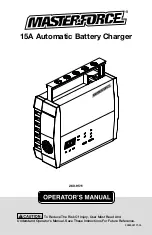
Page 6
produce a short-circuit current high
enough to weld a ring or the like to
metal, causing a severe burn.
2.8
Use charger for charging only 6V and
12V LEAD-ACID (STD, AGM, GEL or
deep-cycle) rechargeable batteries.
It is not intended to supply power to
a low voltage electrical system other
than in a starter-motor application. Do
not use battery charger for charging
dry-cell batteries that are commonly
used with home appliances. These
batteries may burst and cause injury
to persons and damage to property.
2.9
NEVER charge a frozen battery.
3. PREPARING TO CHARGE
3.1
If necessary to remove battery from
vehicle to charge, always remove
grounded terminal from battery first.
Make sure all accessories in the vehi-
cle are off, so as not to cause an arc.
3.2
Be sure area around battery is well
ventilated while battery is being
charged.
3.3
Clean battery terminals. Be careful to
keep corrosion from coming in con-
tact with eyes.
3.4
Add distilled water in each cell until
battery acid reaches level specified by
battery manufacturer. Do not overfill.
For a battery without removable cell
caps, such as valve regulated lead
acid batteries, carefully follow manu-
facturer’s recharging instructions.
3.5
Study all battery manufacturer’s spe-
cific precautions while charging and
recommended rates of charge.
3.6
Determine voltage of battery by
referring to car owner’s manual and
make sure that output voltage selec-
tor switch is set at correct voltage. If
charger has adjustable charge rate,
charge battery initially at lowest rate.
4. CHARGER LOCATION
4.1
Locate charger as far away from bat-
tery as DC cables permit.
4.2
Never place charger directly above
battery being charged; gases from
battery will corrode and damage
charger.
4.3
Never allow battery acid to drip on
charger when reading electrolyte
specific gravity or filling battery.
4.4
Do not operate charger in a closed-in
area or restrict ventilation in any way.
4.5
Do not set a battery on top of charger.
5. DC CONNECTION PRECAUTIONS
5.1
Connect and disconnect DC output
clips only after setting any charger
switches to “off” position and remov-
ing AC cord from electric outlet. Never
allow clips to touch each other.
5.2
Attach clips to battery and chassis,
as indicated in sections 6 and 7.
6. FOLLOW THESE STEPS WHEN BATTERY IS INSTALLED IN VEHICLE
A SPARK NEAR THE BATTERY MAY
CAUSE A BATTERY EXPLOSION. TO
REDUCE THE RISK OF A SPARK NEAR
THE BATTERY:
6.1
Position AC and DC cords to reduce
risk of damage by hood, door, or mov-
ing engine part.
6.2
Stay clear of fan blades, belts, pulleys,
and other parts that can cause injury
to persons.
Содержание 260-9511
Страница 14: ...Page 14 NOTES ...
Страница 15: ...Page 15 NOTES ...
Страница 16: ... 2020 Menard Inc Eau Claire WI 54703 03 2020 ...


































